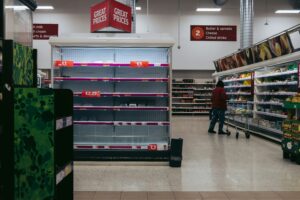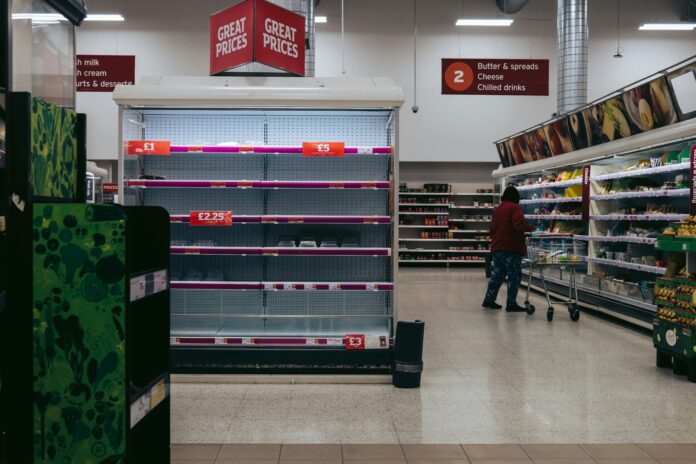In an increasingly interconnected world, the supply chain serves as the backbone of the global economy, ensuring that products reach store shelves and ultimately, our homes. However, the COVID-19 pandemic, geopolitical tensions, and recent natural disasters have exposed the vulnerabilities of this complex system. As a result, the possibility of widespread supply chain disruptions—and the subsequent sight of empty store shelves—is becoming a growing concern.
Let’s explore the potential consequences of a breakdown in the supply chain and what it means for consumers, businesses, and societies at large.
What Causes Supply Chain Disruptions?
The global supply chain is a vast network that connects manufacturers, distributors, and retailers across the world. However, this intricate web can be highly sensitive to various factors:
- Natural Disasters: Earthquakes, hurricanes, floods, and wildfires can severely damage critical infrastructure, leading to delays in production and transportation.
- Pandemics: COVID-19 was a stark example of how a global health crisis can disrupt supply chains, leading to factory shutdowns, labor shortages, and restrictions on transport.
- Geopolitical Conflicts: Tensions between countries can result in sanctions, border closures, or trade restrictions that slow down the flow of goods.
- Economic Instability: Inflation, currency fluctuations, or banking crises can disrupt financing and logistics, making it difficult for businesses to operate smoothly.
- Cybersecurity Threats: A growing number of cyberattacks on critical infrastructure pose a threat to the supply chain, potentially halting operations or corrupting data that companies rely on.
What Happens When Supplies Stop Coming?
If the supply chain were to grind to a halt, the impact on stores and consumers would be immediate and severe:
- Empty Store Shelves: As shipments slow or stop altogether, stores would quickly run out of essential items like food, medicine, and household goods. Panic buying could worsen the situation, leading to even faster depletion of stock.
- Price Inflation: Scarcity of products would drive up prices, making everyday items unaffordable for many people. This could lead to economic hardship, especially for low-income households.
- Business Closures: Retailers and manufacturers depend on regular inventory to keep operations running. A prolonged disruption could force many small businesses to shut down permanently.
- Job Losses: As businesses close or scale down operations, job cuts could follow, resulting in higher unemployment rates and economic instability.
- Social Unrest: The sight of empty shelves and rising prices could lead to public discontent, potentially sparking protests or social unrest, especially if basic necessities become inaccessible.
Examples of Recent Supply Chain Disruptions
- COVID-19 Pandemic: During the height of the pandemic, factories in China—the world’s manufacturing hub—were shut down, causing global shortages in electronics, automotive parts, and medical supplies. The effects were felt in grocery stores too, with a lack of essential items like toilet paper, flour, and canned goods.
- Ever Given Suez Canal Blockage (2021): The accidental blockage of the Suez Canal by the Ever Given cargo ship resulted in a six-day disruption that stranded over 400 vessels. This incident delayed the delivery of goods worth billions of dollars, affecting industries worldwide.
- Chip Shortage in the Automotive Industry: The ongoing global semiconductor shortage has crippled car manufacturers, leading to factory shutdowns and delays in new vehicle production. This shortage has highlighted the overreliance on a limited number of chip manufacturers in Asia.
Preparing for the Worst: How Communities and Individuals Can Cope
While governments and industries are working to create more resilient supply chains, it’s also crucial for individuals to be prepared for possible disruptions. Here are a few strategies:
- Stock Up on Essentials: Having a small stockpile of non-perishable food, medicine, and other essentials can provide peace of mind during times of uncertainty.
- Support Local Businesses: By sourcing goods locally, communities can reduce their dependence on global supply chains and strengthen local economies.
- Grow Your Own Food: Urban gardening, community gardens, and hydroponics can help supplement household food supplies in case of shortages.
- Learn Basic Skills: In a prolonged supply chain breakdown, knowing how to repair household items, cook from scratch, or grow food could be invaluable.
Long-Term Solutions: Building Resilient Supply Chains
To prevent future disruptions, companies and governments are exploring ways to make supply chains more robust:
- Diversification of Suppliers: Instead of relying on a single country or supplier, companies are looking to diversify their sources to reduce risk.
- Local Production: Bringing manufacturing closer to home can reduce transportation times and create jobs, although it might increase costs.
- Advanced Technologies: The use of AI, blockchain, and IoT (Internet of Things) can help companies monitor their supply chains in real-time, allowing them to quickly respond to potential disruptions.
- Sustainable Practices: By focusing on sustainability, companies can reduce waste, conserve resources, and build supply chains that are better prepared to handle environmental challenges.
The COVID-19 pandemic, natural disasters, and geopolitical tensions have served as wake-up calls for how fragile our global supply chains can be. The sight of empty store shelves is a harsh reminder of just how reliant we are on a system that, while efficient, is also vulnerable to sudden shocks. As we look to the future, building more resilient and sustainable supply chains will be essential to ensuring that societies can withstand whatever challenges may come their way.
By preparing for potential disruptions and learning to live more sustainably, both individuals and communities can better navigate the uncertainties of an unpredictable world.

Photo by Sandie Clarke on Unsplash
Views: 2






